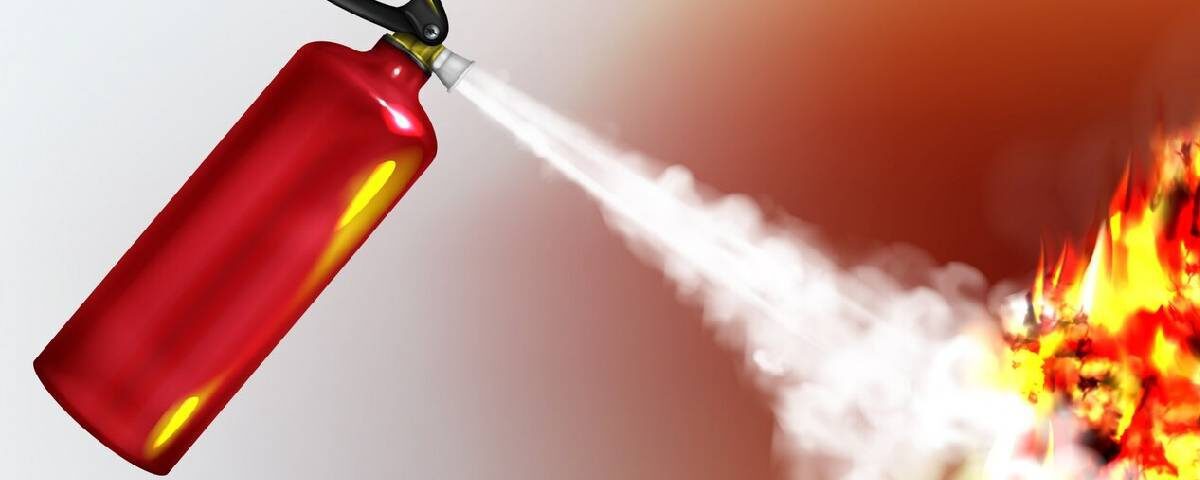DCP Fire Extinguishers in Qatar – Supply, Installation & Maintenance.

What is a Clean Agent Fire Suppression System?
October 29, 2023
Qatar Civil Defence Renewal Certification: Everything You Need to Know
November 29, 2023Fire safety is a critical concern in Qatar, whether it’s for homes, offices, commercial kitchens, or industrial settings. In order to ensure safety and protection against fires, it is essential to have the right fire extinguisher. One such important type is the DCP (Dry Chemical Powder) fire extinguisher. DCP fire extinguishers are highly effective in suppressing and extinguishing fires of different classes, making them versatile and suitable for various settings.
DCP fire extinguishers, also known as dry chemical powder extinguishers, are the most versatile and widely used type of fire extinguisher in Qatar. Their effectiveness against a wide range of fires, coupled with their ease of operation, makes them an indispensable tool for both homes and businesses. In this comprehensive guide, we delve into the world of DCP fire extinguishers in Qatar, equipping you with the knowledge and resources to make informed decisions about fire safety.
This blog will discuss the importance of DCP fire extinguishers in Qatar, including their installation, maintenance, inspection, training, and certification. We will delve into the specific needs for homes, offices, commercial kitchens, and industries, and provide essential information on finding a reputable supplier. By understanding and prioritizing DCP fire extinguishers, you can play a vital role in ensuring safety and protecting lives and properties.
The Importance of Fire Safety in Qatar
Fire safety is not a luxury; it is a fundamental responsibility, a collective effort to protect lives and property. In Qatar, where the population has witnessed a remarkable surge in recent years, the need for fire safety awareness has escalated. The densely populated urban areas, with their intricate network of buildings and infrastructure, pose unique challenges in fire prevention and response.
The consequences of fire can be devastating, not only for the immediate victims but for the entire community. Loss of life, property damage, and economic disruptions are just a few of the tragic repercussions of fire. In Qatar, where the construction industry is booming, the risk of fire is particularly heightened, as new buildings rise and electrical systems become increasingly complex.
To combat these challenges, Qatar has implemented stringent fire safety regulations, mandating the installation and maintenance of fire protection systems in all buildings. These regulations are enforced by the Qatar Civil Defense, a dedicated organization committed to safeguarding the community from fire hazards.
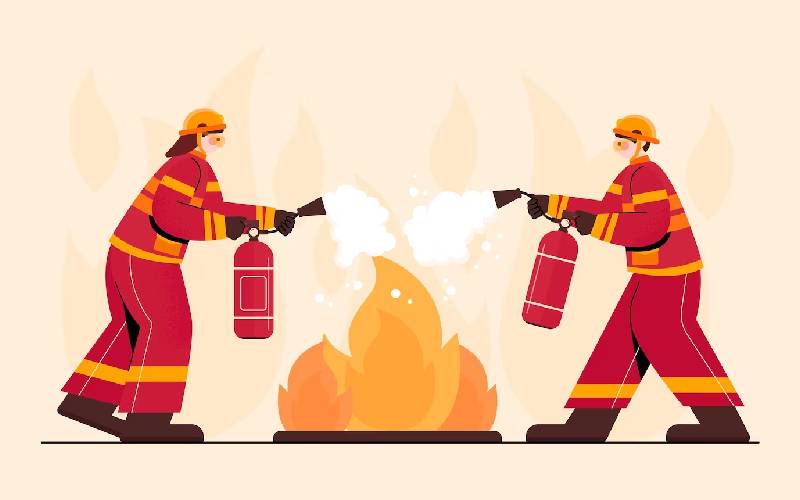
What are DCP Fire Extinguishers?
In the face of fire’s relentless rage, DCP fire extinguishers stand as unwavering guardians, their presence a comforting reassurance amidst the chaos. These unsung heroes, with their unassuming red bodies, are the first line of defense against common fires, their potent dry chemical powder capable of extinguishing flames and saving precious lives.
Understanding the Anatomy of a DCP Fire Extinguisher
DCP fire extinguishers, also known as dry chemical powder fire extinguishers, are comprised of several key components that work in unison to combat the threat of fire.
Cylinder: The sturdy cylinder, typically made of steel or aluminum, houses the pressurized dry chemical powder, the heart of the fire extinguisher.
Expelling Agent: This pressurized gas, often nitrogen or carbon dioxide, forces the dry chemical powder out of the cylinder with tremendous force, propelling it toward the fire.
Valve: The valve serves as the gatekeeper, controlling the release of the dry chemical powder. It allows for precise control over the flow of powder, ensuring effective extinguishing while preventing unnecessary waste.
Discharge Nozzle: The discharge nozzle directs the flow of dry chemical powder, allowing for accurate targeting of the fire. It can be adjusted to create a focused jet or a broader spray, depending on the size and nature of the fire.
Dry Chemical Powder: The star of the show, the dry chemical powder, is a finely ground mixture of various chemicals, typically sodium bicarbonate and potassium chloride. Upon contact with flames, this powder disrupts the combustion process, rapidly extinguishing the fire.
Why DCP Fire Extinguishers are Essential in Qatar
In order to fully grasp the importance of DCP fire extinguishers in Qatar, it is crucial to understand the risks associated with fires. Qatar experiences high temperatures throughout the year, making it susceptible to fire incidents. These incidents can occur in various settings, such as homes, offices, commercial kitchens, and industrial sites, presenting different types of fire hazards.
DCP fire extinguishers are specifically designed to combat fires of different classes, including Class A (ordinary combustibles), Class B (flammable liquids), and Class C (electrical fires). This versatility makes them a vital tool in ensuring the safety of individuals and protecting valuable assets.
Whether it’s a small fire in a residential kitchen or a large-scale fire in an industrial facility, DCP fire extinguishers can swiftly and effectively suppress the flames. Their ability to smother fires by disrupting the chemical reaction between fuel and oxygen is what sets them apart from other extinguisher types.
By having DCP fire extinguishers readily available and properly maintained, occupants can take immediate action when a fire breaks out. This not only aids in the prompt containment of the fire but also helps minimize the potential damage to property, reduce the risk of injury, and ultimately save lives.
How DCP Fire Extinguishers Extinguish Flames
DCP fire extinguishers, short for dry chemical powder fire extinguishers, are versatile and effective firefighting tools that have become ubiquitous in homes, workplaces, and public spaces. Their ability to combat a wide range of fires, from Class A (combustible materials) to Class B (flammable liquids) and Class C (combustible gases), makes them indispensable for fire safety. But how do these unassuming canisters effectively extinguish flames? Let’s delve into the science behind DCP fire extinguishers and uncover the mechanisms that make them so effective in suppressing combustion.
1. Smothering and Disrupting the Fire Triangle
Combustion, the process of burning, requires three essential elements: fuel, heat, and oxygen. The fire triangle represents these elements, and the removal of any one element will disrupt the combustion process and extinguish the fire. DCP fire extinguishers primarily operate by smothering the fire, preventing oxygen from reaching the burning fuel.
Upon activation, the DCP extinguisher expels a pressurized stream of fine, non-combustible powder. This powder, composed primarily of sodium or potassium bicarbonate, forms a cloud around the fire, effectively blocking the flow of oxygen. Without oxygen, the chemical reactions that sustain combustion cannot occur, and the fire is extinguished.
In addition to smothering, DCP powder also plays a role in disrupting the fire triangle by interfering with the heat transfer process. The powder particles absorb heat from the burning fuel, reducing its temperature and making it less likely to ignite nearby combustible materials. This cooling effect further contributes to extinguishing the fire.
2. Interfering with the Chemical Chain Reaction of Combustion
Combustion is not merely a physical process; it is a complex chemical chain reaction involving a series of rapidly occurring molecular interactions. DCP fire extinguishers can disrupt this chain reaction by introducing chemical agents that interfere with the combustion process.
The sodium or potassium bicarbonate powder used in DCP extinguishers decomposes upon contact with heat, releasing carbon dioxide and water vapor. These decomposition products act as chemical inhibitors, slowing down or even stopping the chemical reactions that sustain combustion. This interference further contributes to extinguishing the fire.
3. Versatility against Class A, B, and C Fires
DCP fire extinguishers are particularly effective against Class A, B, and C fires. Their ability to smother and disrupt the fire triangle makes them suitable for extinguishing fires involving combustible materials (Class A), flammable liquids (Class B), and combustible gases (Class C).
For Class A fires, the thick layer of powder effectively excludes oxygen, preventing the burning of materials like wood, paper, and textiles. In Class B fires, the powder forms a barrier between the burning liquid and the surrounding air, preventing further vaporization and combustion. And for Class C fires, the powder disperses and disrupts the combustible gases, preventing them from igniting or spreading.
When using a DCP fire extinguisher, it is crucial to maintain a safe distance from the fire and aim the stream of powder at the base of the flames. It is also essential to inspect and maintain DCP extinguishers regularly to ensure their optimal performance and readiness in case of an emergency.
Types of Fires DCP Fire Extinguishers are Effective Against
DCP fire extinguishers are versatile tools in the fight against fire, proving their effectiveness against a range of common fire hazards.
Class A Fires: Class A fires involve ordinary combustibles such as wood, paper, cloth, and plastics. These materials are characterized by their ability to burn rapidly and produce significant amounts of heat and smoke. DCP fire extinguishers effectively extinguish Class A fires by disrupting the combustion process. The fine powder coats the burning material, preventing oxygen from reaching the fuel and suppressing the fire.
Class B Fires: Class B fires involve flammable and combustible liquids such as gasoline, oil, grease, and paints. These liquids pose a significant hazard due to their ability to spread rapidly and ignite easily. DCP fire extinguishers effectively extinguish Class B fires by smothering the flames and preventing the re-ignition of flammable vapors. The powder forms a barrier that isolates the burning liquid from oxygen, effectively extinguishing the fire.
Class C Fires: Class C fires involve energized electrical equipment such as appliances, motors, and wiring. These fires present a unique challenge due to the risk of electrical shock. DCP fire extinguishers effectively extinguish Class C fires by smothering the flames and interrupting the electrical current. The non-conductive powder forms a barrier that prevents the passage of electricity, ensuring the safety of the user and minimizing electrical damage.
The versatility and effectiveness of DCP fire extinguishers make them an essential component of fire safety plans in homes, businesses, and industrial settings. Their ability to quickly extinguish common fires and protect property and lives makes them indispensable guardians against the unpredictable threat of fire.
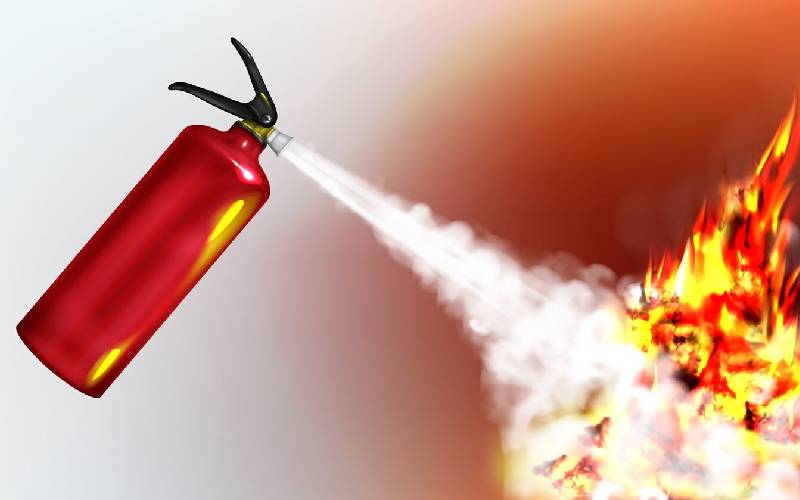
Applications of DCP Fire Extinguishers in Qatar
Fire hazards pose a significant threat to homes, businesses, and industrial facilities in Qatar. Common causes of fire include electrical faults, improper storage of flammable materials, and careless cooking practices. DCP fire extinguishers, also known as dry chemical powder fire extinguishers, are versatile and effective tools for combating a wide range of fires.
Common Fire Hazards in Qatar
Qatar’s rapidly developing infrastructure and diverse industrial activities increase the potential for fire outbreaks. Common fire hazards in Qatar include:
Electrical Fires: Electrical faults and malfunctions are a leading cause of fire incidents in Qatar. Overloaded circuits, faulty wiring, and damaged appliances can trigger electrical fires, often spreading rapidly through buildings.
Flammable Material Storage Fires: Improper storage of flammable materials, such as solvents, gasoline, and paints, poses a significant fire risk. These materials can easily ignite when exposed to heat or sparks, leading to uncontrolled fires.
Cooking Fires: Careless cooking practices are a common cause of residential fires in Qatar. Leaving unattended cooking appliances, overheating cooking oil, and using flammable liquids near open flames can quickly result in kitchen fires.
Recommended Use of DCP Fire Extinguishers in Various Settings
DCP fire extinguishers are suitable for combating a variety of fires, making them a valuable tool for fire protection in various settings. Here are some recommended uses of DCP fire extinguishers:
Homes: DCP fire extinguishers are essential safety equipment in homes, providing protection against common household fires. They are effective against Class A (ordinary combustibles), Class B (flammable liquids), and Class C (electrical fires).
Businesses: Businesses of all sizes should equip their premises with DCP fire extinguishers to safeguard against potential fire hazards. DCP extinguishers are particularly useful in kitchens, workshops, and storage areas where flammable materials are present.
Industrial Facilities: Industrial facilities face unique fire risks due to the presence of hazardous chemicals, machinery, and flammable substances. DCP fire extinguishers are an integral part of industrial fire safety plans, providing a reliable means of extinguishing fires involving flammable liquids, gases, and chemicals.
Examples of Specific Applications of DCP Fire Extinguishers
DCP fire extinguishers are versatile and can be used to combat a variety of fires in specific situations. Here are some examples of specific applications:
Extinguishing cooking oil fires: DCP fire extinguishers are effective in extinguishing cooking oil fires by smothering the flames and preventing the spread of the fire.
Containing electrical fires: If an electrical fire occurs, DCP fire extinguishers can be used to isolate the source of the fire and prevent further damage to electrical equipment.
Extinguishing flammable liquid fires: DCP fire extinguishers are effective against fires involving flammable liquids, such as gasoline, solvents, and paints.
Combating chemical fires: DCP fire extinguishers can be used to extinguish fires involving certain types of chemicals, but it is important to consult the Safety Data Sheet (SDS) of the specific chemical to ensure the extinguisher is compatible.
By understanding the common fire hazards in Qatar and the recommended uses of DCP fire extinguishers in various settings, individuals and businesses can make informed decisions about fire protection strategies. DCP fire extinguishers, when used properly and maintained regularly, can serve as effective first responders in the fight against fire, safeguarding property and lives.
The Unique Features of DCP Fire Extinguishers
DCP fire extinguishers, also known as Dry Chemical Powder fire extinguishers, boast several unique features that make them highly effective in fighting different types of fires. One of the key advantages of DCP fire extinguishers is their ability to tackle fires of various classes, including Class A, Class B, and Class C.
These extinguishers contain a dry chemical powder, typically a combination of monoammonium phosphate and ammonium sulfate. When discharged onto a fire, the powder creates a chemical reaction that quickly suppresses the flames. The powder acts as a blanket, smothering the fire and depriving it of oxygen.
Another distinctive feature of DCP fire extinguishers is their ease of use. They are designed to be user-friendly, allowing anyone to operate them efficiently during an emergency. The discharge nozzle and lever, conveniently located on the extinguisher, ensure quick and accurate application of the powder onto the fire.
Furthermore, DCP fire extinguishers are known for their effectiveness in rapidly extinguishing fires. The dry chemical powder has excellent fire-fighting properties, making it highly effective in controlling and extinguishing various types of fires, whether it be a wood fire, flammable liquid fire, or an electrical fire.
In the upcoming section, we will discuss the proper installation and maintenance of DCP fire extinguishers. Stay tuned to learn the necessary steps to ensure the longevity and functionality of these essential fire safety devices.
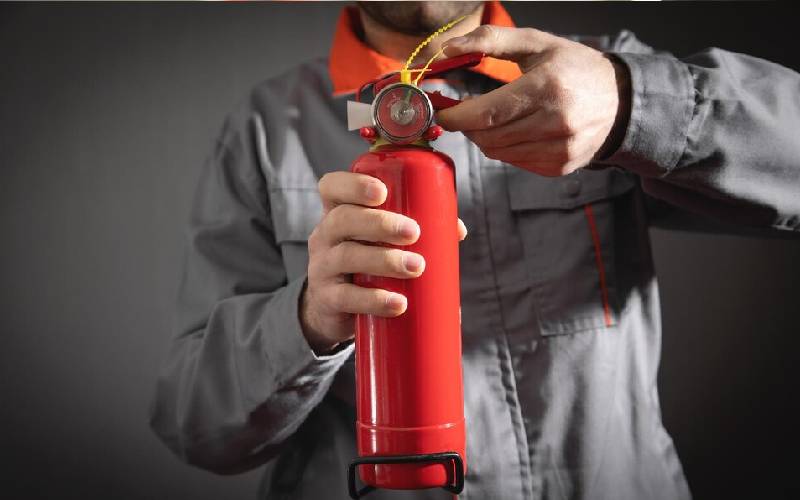
Expert Installation of DCP Fire Extinguishers in Qatar
In the face of a fire, every second counts. The ability to quickly and effectively extinguish a fire can mean the difference between a minor incident and a devastating catastrophe. That’s why having the right fire extinguishers in place is crucial, and ensuring they are properly installed is paramount.
A Step-by-Step Guide to DCP Fire Extinguisher Installation
Installing a DCP fire extinguisher may seem like a simple task, but it requires careful consideration and precise execution. Here’s a step-by-step guide to ensure proper installation:
Choose the Right Location: Select a visible, easily accessible location, away from heat sources and potential obstructions. Consider the fire hazards in the area and ensure the extinguisher is within reach.
Mounting Height: Mount the extinguisher at a height that is easy to reach for both adults and children. Generally, a height between 48 and 60 inches from the floor is recommended.
Secure Mounting: Use the appropriate mounting bracket or hook, ensuring it is securely anchored to the wall or other stable surface. The extinguisher should be firmly attached, eliminating any risk of falling.
Orientation: Mount the extinguisher with the nozzle facing outward, making it easy to grab and operate in a hurry.
Clearance: Ensure there is adequate clearance around the extinguisher, allowing for unrestricted access and operation.
Inspection and Maintenance: Regularly inspect the mounting and ensure the extinguisher remains secure. Follow recommended maintenance schedules to keep the extinguisher in top condition.
Importance of Hiring Qualified Professionals
While the steps involved in installing a DCP fire extinguisher may seem straightforward, there are several nuances and safety considerations that only qualified professionals possess. Hiring a reputable fire protection company ensures that your extinguishers are installed correctly, adhering to local regulations and safety standards.
Experienced technicians will conduct a thorough site assessment to identify the most suitable locations for your extinguishers, taking into account factors such as fire hazards, accessibility, and potential obstructions. They will also provide expert guidance on the selection of appropriate extinguishers based on the specific fire risks in your premises.
Moreover, qualified professionals will ensure that the extinguishers are securely mounted, using the correct tools and techniques to prevent accidental dislodgement. They will also conduct a final inspection to verify that the extinguishers are positioned correctly, easily accessible, and clearly labeled.
Professional installation offers several advantages:
Expertise and Experience: Trained technicians are well-versed in the various types of fire extinguishers, their proper installation procedures, and the specific requirements of different environments. They can assess the site hazards and select the most suitable location for the extinguisher.
Safety Compliance: Professionals are up-to-date with the latest fire safety codes and regulations, ensuring that the installation complies with all applicable standards. This minimizes the risk of legal liabilities and ensures the safety of occupants.
Warranty Coverage: Many reputable fire extinguisher companies offer warranties on their installation services, providing peace of mind and protection against potential defects or malfunctions.
Specialized Equipment: Professional installers often utilize specialized tools and equipment to ensure that the fire extinguisher is mounted securely and safely. This can be particularly important for larger or heavier extinguishers.
Peace of Mind: By entrusting the installation to qualified professionals, you can rest assured that your fire extinguisher is properly installed and ready to perform effectively in the event of a fire.
Remember, a fire extinguisher is your first line of defense against a fire emergency. Investing in professional installation is an investment in your safety, ensuring that you have the right tools and the right knowledge to combat the unpredictable fury of fire.
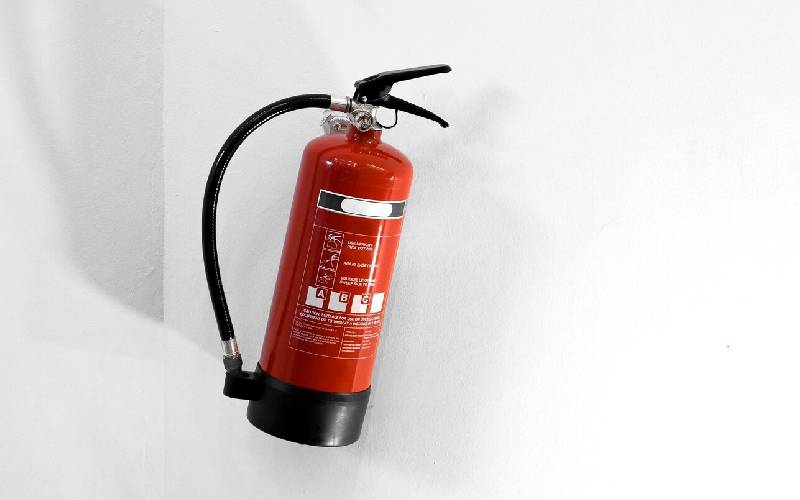
Maintenance and Inspection of DCP Fire Extinguishers in Qatar
DCP fire extinguishers, like any mechanical device, are susceptible to wear and tear over time. Regular maintenance helps to identify and rectify any potential issues before they can compromise the extinguisher’s functionality. Additionally, proper inspection ensures that the extinguisher is pressurized to the correct level, that the extinguishing agent is free of contaminants, and that the operating mechanisms are functioning smoothly. By adhering to a regular maintenance schedule, you can maintain the integrity of your DCP fire extinguishers, ensuring that they are ready to effectively suppress fires when needed.
Importance of Maintenance and Inspection
Regular maintenance and inspection of DCP fire extinguishers are paramount for several reasons:
Ensures Optimal Performance: Regular maintenance helps maintain the optimal performance of DCP extinguishers, ensuring they will function effectively when needed. This includes checking for proper pressure, ensuring the operability of the discharge mechanism, and verifying the integrity of the cylinder and hose.
Detects Early Signs of Malfunction: Inspections allow for the early detection of potential problems, such as leaks, corrosion, or damage to the extinguisher’s components. Prompt identification of these issues prevents premature failure and ensures the extinguisher remains reliable in an emergency.
Complies with Regulations: Many jurisdictions have regulations requiring regular maintenance and inspection of fire extinguishers in commercial and residential settings. Failure to comply with these regulations can result in fines or even legal liability in the event of a fire.
Maintenance Procedures
Maintenance procedures for DCP fire extinguishers typically involve the following steps:
Visual Inspection: Carefully examine the extinguisher for any signs of damage, corrosion, or leaks. Check the pressure gauge to ensure it is within the acceptable range. Inspect the hose for cracks or wear and tear.
Internal Examination: Every 6 years, DCP fire extinguishers require an internal examination by a qualified technician. This involves removing the extinguishing agent, inspecting the cylinder and internal components, and recharging the extinguisher.
Pressure Testing: Hydrostatic testing is required every 12 years for stored-pressure DCP fire extinguishers. This involves pressurizing the cylinder with water or another non-compressible fluid to test its structural integrity.
Inspection Frequency
The frequency of inspections for DCP fire extinguishers depends on the type of extinguisher and the environment in which it is located:
Monthly Inspection: All DCP fire extinguishers should be visually inspected monthly to check for any visible damage, leaks, or signs of malfunction.
Annual Inspection: An annual inspection by a qualified technician is recommended for all DCP fire extinguishers. This inspection should include a more thorough visual examination, pressure gauge check, and functional testing of the discharge mechanism.
Additional Tips
Recordkeeping: Maintain a record of all maintenance and inspection activities, including dates, technician information, and any observations or repairs made. This documentation can be valuable for insurance purposes and to demonstrate compliance with regulations.
Training: Familiarize yourself with the operation of DCP fire extinguishers and ensure all occupants in your building or home are similarly trained. This includes understanding the PASSS acronym (Pull, Aim, Squeeze, Sweep) and how to properly use the extinguisher in various fire scenarios.
Seek Professional Assistance: For any internal examination, pressure testing, or repairs beyond your expertise, contact a qualified fire extinguisher technician. They have the necessary training and equipment to ensure the proper maintenance and functionality of your fire extinguishers.
By following these guidelines for maintenance and inspection, you can ensure that your DCP fire extinguishers remain in top condition, ready to protect you and your property from the devastating effects of fire. Remember, a well-maintained fire extinguisher is your first line of defense against fire hazards.
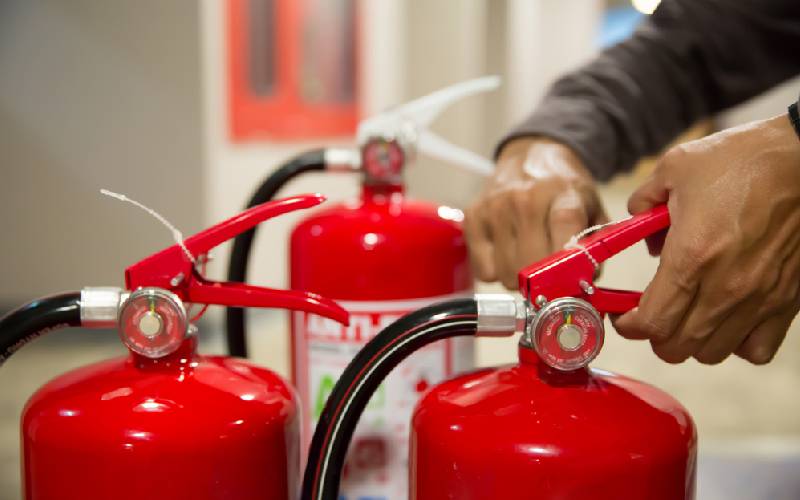
The Role of DCP Fire Extinguishers in Fire Protection
DCP fire extinguishers, also known as dry chemical powder fire extinguishers, stand as the first line of defense against common fires. These versatile devices are designed to extinguish Class A (combustible materials such as wood, paper, and textiles), Class B (flammable liquids such as petrol and oil), and Class C (electrical fires).
The effectiveness of DCP fire extinguishers lies in their ability to disrupt the chemical chain reaction that sustains combustion. The dry chemical powder, upon discharge, forms a cloud that smothers the fire, preventing the oxygen supply necessary for flames to persist. This mechanism makes DCP fire extinguishers particularly effective in combating small to medium-sized fires, preventing them from escalating into larger conflagrations.
DCP fire extinguishers are ubiquitous in Qatar, found in homes, offices, schools, hospitals, and public spaces. Their ease of use and adaptability make them an essential component of any fire safety plan. With proper training and understanding, anyone can operate a DCP fire extinguisher effectively, empowering individuals to take control in the event of a fire emergency.
The presence of DCP fire extinguishers serves as a powerful reminder of our collective responsibility for fire safety. These unsung heroes stand ready to protect us, but only if we equip ourselves with the knowledge and skills to utilize them effectively. By understanding the importance of fire safety and appreciating the role of DCP fire extinguishers, we can transform Qatar into a fire-safe haven, where the threat of flames is no longer a source of fear but a reminder of our unwavering commitment to safety.
How to Find Reliable Suppliers of DCP Fire Extinguishers in Qatar
When it comes to ensuring your safety and protection, it is important to find reliable suppliers of DCP fire extinguishers in Qatar. With the booming construction and infrastructure development in the country, there are several options available. However, it is imperative to choose a supplier that provides high-quality, certified fire extinguishers that meet the local safety standards.
One way to find reliable suppliers is by checking with local fire departments or safety agencies for recommendations. They often have a list of approved suppliers who have met the necessary requirements. Additionally, online research can help you identify reputable suppliers with a proven track record in providing reliable fire safety equipment.
Remember, your safety is too important to compromise. Don’t settle for anything less than the best when it comes to fire extinguishers. Choose a supplier that you can trust to provide you with the highest level of safety and protection.
Conclusion
The importance of DCP fire extinguishers in Qatar cannot be understated when it comes to ensuring safety and protection. However, it is not enough to simply purchase these extinguishers. Regular maintenance and training are equally vital to their effectiveness.
By conducting routine inspections and maintenance, you can guarantee that these extinguishers are always in proper working condition and readily available during emergencies. Additionally, providing proper training to employees or occupants on how to use these extinguishers effectively and safely is essential.
Remember that fire extinguishers are only helpful if they are well-maintained and used by trained individuals. By investing your time and effort into regular maintenance and training, you are taking significant steps towards ensuring the safety and protection of everyone in your environment.
Protect your property and loved ones with our comprehensive DCP fire extinguisher services:
Protect your property and ensure the safety of your loved ones with our comprehensive DCP fire extinguisher services. Our expert technicians provide supply, installation, and maintenance services to keep your fire extinguishers in top condition and ready to combat any fire emergency. Contact us today for a free quote and safeguard your premises from the devastating effects of fire.
We offer a wide range of services, including:
Supply: We provide high-quality DCP fire extinguishers to meet your specific needs and requirements.
Installation: Our experienced technicians will expertly install your fire extinguishers in the most strategic locations for optimal protection.
Maintenance: We offer regular maintenance services to keep your fire extinguishers in top condition, ensuring they’re ready to combat any fire emergency.
Don’t wait until it’s too late. Contact us today to schedule your DCP fire extinguisher services and safeguard your property from the devastating effects of fire.
We’re committed to providing you with the best possible fire protection solutions to keep your property and loved ones safe.
To contact us:
- Call us at: +974 55324195
- Email us at: sales@ceasefireme.com
We look forward to hearing from you!

